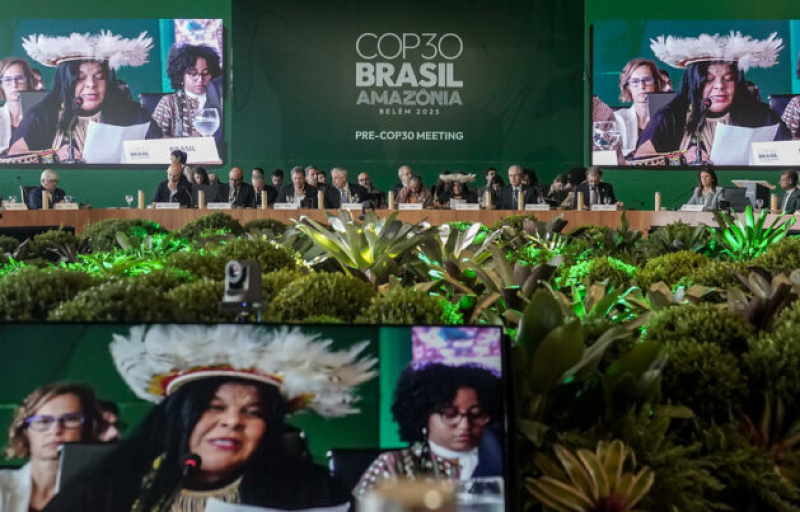- অতিথি পাখির বিচরণ আর দুষ্টুমিতে নান্দনিক হয়ে উঠেছে কুয়াকাটার চর বিজয় |
- Remittance inflow exceeds $632 million in first six days of Dec |
- 18 migrants die as inflatable boat sinks south of Greek island of Crete |
- TIB for polls manifesto vows to curb misuse of powers and religion |
- Khaleda now not fit for travelling: Medical Board |
Strengthening Indigenous Land Rights Can Curb Amazon Deforestation

Strengthening Indigenous land rights will protect more forest in Brazil’s Amazon and prevent large amounts of carbon emissions, according to new research released ahead of COP30.
An analysis by the Environmental Defense Fund (EDF) finds Indigenous lands and protected areas are key to reducing deforestation; without them, Brazilian Amazon forest loss would be 35 percent higher, resulting in nearly 45 percent more carbon emissions.
At a time when the Amazon is steadily losing forest cover and approaching an irreversible tipping point, the report states: “Placing more forests under Indigenous or government protection could prevent up to an additional 20 percent of deforestation and 26 percent of carbon emissions by 2030.”
The analysis, “The Importance of Protected Areas in Reducing Deforestation in the Legal Amazon,” also finds that current protected areas—including Indigenous lands and conservation units—will prevent an estimated total of 4.3 million hectares of deforestation between 2022 and 2030 in the nine Brazilian states. This would avoid 2.1 GtCO₂e (gigatons of carbon dioxide equivalent), more than Russia’s annual carbon emissions, or approximately 5.6 percent of global annual emissions.
Approximately 63.4 million hectares of Brazilian Amazon forests remain unprotected. If designated as Indigenous lands or protected areas, losses from land grabbing, cattle ranching, soy farming, or other destructive activities could be avoided.
“The Amazon, as all climate scientists now clearly agree, is approaching a tipping point, which, if crossed, could cause much of the ecosystem to unravel and transform from forest into scrub savannah,” said Steve Schwartzman, Associate Vice President for Tropical Forests at EDF.
“How close we are to the tipping point is unclear, but deforestation must stop, and we need to begin restoring areas that have been lost.”
He added that the future of the world’s largest rainforest depends on protecting Indigenous territories, protected areas, and Quilombola lands.
“As delegates gather for COP30, it is critical that they have evidence showing the most effective solutions,” he said.
Belém, a Brazilian city in the Amazon region, will host the annual UN climate talks from November 10–21.
The research shows lands managed by Indigenous Peoples have lower deforestation rates and store significantly more carbon than other areas. Between 1985 and 2020, 90 percent of Amazon deforestation occurred outside Indigenous lands, with only 1.2 percent of native vegetation lost within them.
Amazon territories managed by Indigenous communities with recognized land rights have stored far more carbon than they emitted. Between 2001 and 2021, they released around 120 million metric tons of carbon (CO₂) annually while removing 460 million metric tons.
The nine states of the Legal Amazon—Acre, Amapá, Amazonas, Mato Grosso, Maranhão, Pará, Rondônia, Roraima, and Tocantins—contain approximately 60 percent of the Amazon rainforest, which spans eight South American countries. Of the region’s total 510 million hectares, around 393 million hectares were covered by native vegetation in the Amazon, Cerrado, and Pantanal biomes in 2022. By the end of 2021, 112.5 million hectares had been deforested.
“Protected areas in the Brazilian Legal Amazon are critical for preserving native vegetation, carbon stocks, biodiversity, ecosystem services, and the livelihoods of Indigenous and local communities. Our model shows that protected areas prevent deforestation both within and beyond their boundaries due to spatial interactions across the landscape,” said Breno Pietracci, an environmental economist and lead researcher.
As countries prepare to present their Nationally Determined Contributions (NDCs) at COP30, Indigenous Peoples in Brazil have pushed governments to recognize Indigenous lands, support Indigenous-led climate solutions, and strengthen legal protections.
“We cannot protect the Amazon, where Quilombola and Afro-descendant communities live, without recognizing their rights in climate negotiations at the UN,” said Denildo “Bico” Rodrigues de Moraes, executive coordinator of the National Coordination of Black Rural Quilombola Communities (CONAQ). “Recognition of our rights is essential in these negotiations.”

